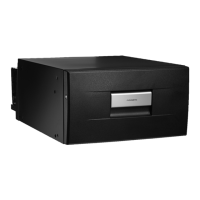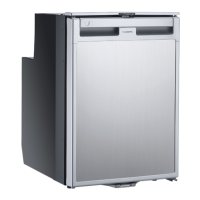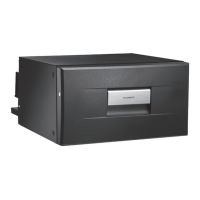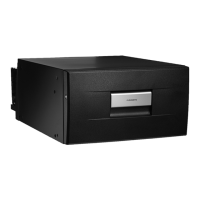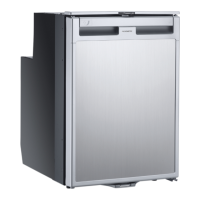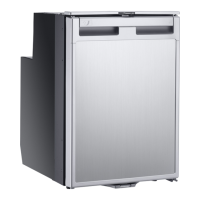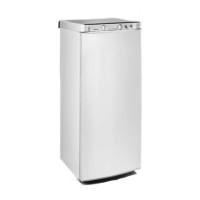11
EN
Refrigerators Diagnostic Procedures
5.2 Error-Based Diagnostics
The thermostat assembly has two LED indicator
lights. The green light is used to indicate that the
system is receiving voltage. The red light will flash (for
approximately one quarter of a second) to indicate any
operational errors that are identified.
Refer to the following table to diagnose system errors
based on the flash sequences from this indicator light.
I
The CD 30 series refrigerators do not include
an LED thermostat assembly, so the following
information does not apply.
Flashes Fault Description Possible Cause Recommended Action Page
1 Low Voltage Cutoff
1
The control module experiences
voltage at or below 11.7 VDC
upon compressor startup, or
the voltage has dropped to
10.4 VDC or below aer the
compressor is running.
Monitor the voltage at the input of the control
module to ensure that there is not a voltage drop
below 0.2 VDC when the compressor attempts to
start. If the voltage drop is greater than 0.2 VDC:
• Inspect the truck wiring and all connections for
loose or corrosive terminals.
• Check for a weak cell in the truck battery.
12
2
Too Many Start
Attempts
The compressor attempts too
many starts within one minute.
• Allow the refrigerator to sit with the thermostat
set to the coldest setting, with power applied,
for two minutes to clear the fault.
• If the fault continues, complete the actions
described for the fan overload current fault.
N/A
Fan Overload
Current
The fan draws more than 0.5
amps.
• Locate and remove the wire from terminal
“F”on the control module (negative terminal
for the fan circuit).
• Attempt to restart refrigerator.
• If the fault continues, replace the control
module. If not, replace the condenser fan.
13/17
3 Motor Start Error
2
The rotor is jammed.
• Turn the unit off for fieen minutes, and then
turn the unit back on.
• Using a multimeter, verify that the compressor
pins show 2.2 – 2.5 ohms between all three
pins, and ensure that there are no shorts to
ground.
• If the ohm readings are within specification,
replace the control module.
• If the fault still occurs, replace the refrigerator.
13
The pressure difference in the
cooling system is too high
(> 5 bar).
4
Minimum Speed
Error
The cooling system is too heavily
loaded, and the compressor
cannot maintain a high enough
RPM (1,850 RPMs).
• Remove all items from the unit, and let it cool
down to the set temperature while empty.
• Using a multimeter, verify that the compressor
pins show 2.2 – 2.5 ohms between all three
pins and ensure that there are no shorts to
ground.
• If the ohm readings are within specification,
replace the control module.
13
5 Thermal Cut-Off
3
There is a lack of proper
ventilation.
• Remove the unit from the truck, and place it in
a well ventilated area. If the unit starts working
correctly, then the issue is a lack of ventilation
around the unit, or it is too hot in the truck.
• If the fault persists, replace the control module.
13
The cooling system is too heavily
loaded, causing the electronics
to overheat.
6
4
NTC Sensor Error The NTC sensor is defective. Replace the NTC sensor. 21
1
You may not actually see the voltage dip all the way to 10.4 VDC voltage cut out. The module has a voltage sensor that can read voltage more quickly than most
common Fluke meters. If any voltage drop is present, this issue must be corrected.
2
There is no way to bypass the module. Trying to do so with 12 VDC power will damage the compressor. The compressor is actually a three phase AC motor that
the module powers.
3
Heat must be removed from the rear of the refrigerator for proper operation. The design temperatures are 14 °F – 110 °F (-10 °C – 43 °C). Lack of ventilation can
lead to premature compressor failure or poor cooling capabilities. There must be a minimum of 36 square inches of opening to the outside for ventilation, and a
minimum of four inches of clearance behind the refrigerator. Two openings are recommended. Ventilation air must have a clear path in and a clear path out.
4
Although the LED light flashes six times in succession, it will appear to blink continuously.

